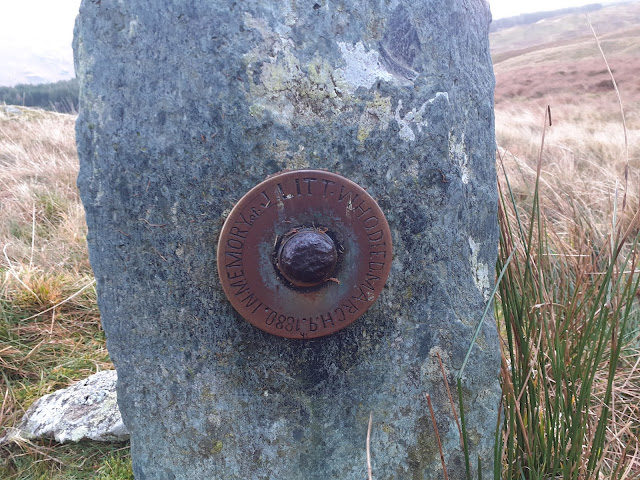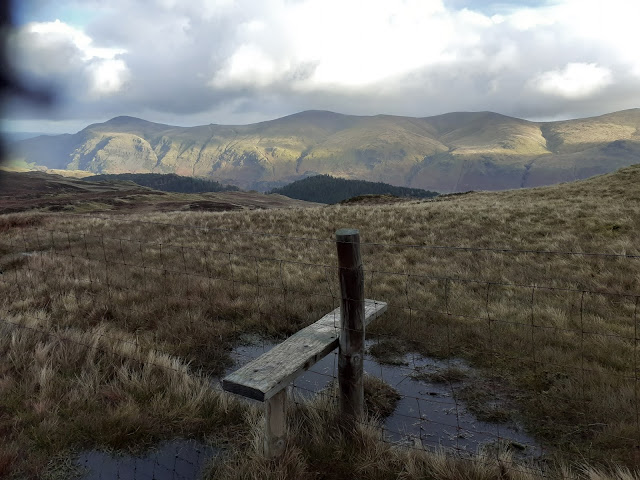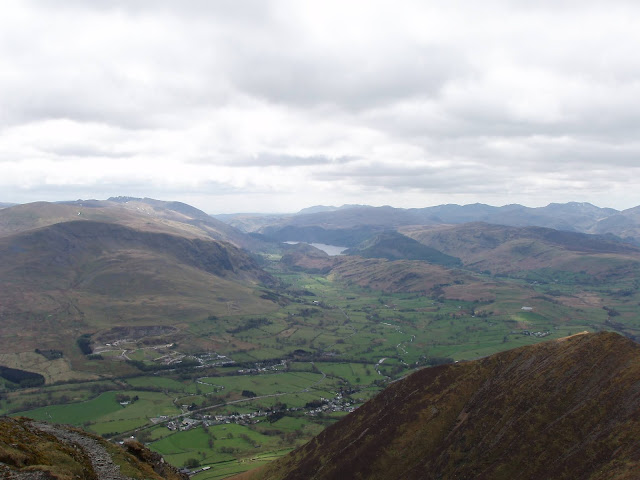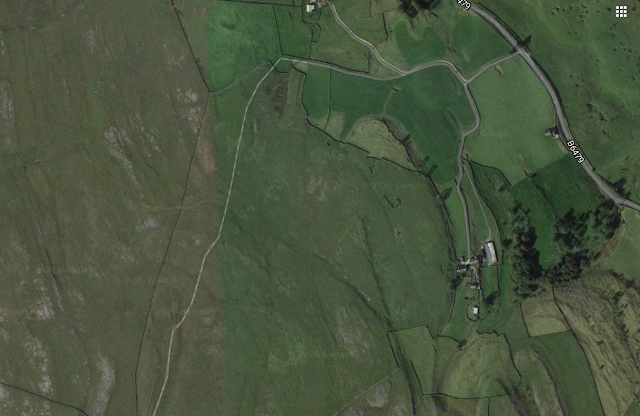 |
| The Thomas Clarkson Anti-Slavery Memorial at Eusemere, Pooley Bridge |
Slavery issues – Ullswater
Cumbria had its clear connections with slavery,
particularly the coastal town of Whitehaven with its Caribbean connections,
indicated through the references to rum (The Rum Story) and Cumberland Rum
Butter as a delicacy now eaten at Christmas, though back in those times, eaten
from a particular dish at celebrations such as births. However, one would not
have expected it to be a hotbed of the Abolitionist, or Anti-Slavery Movement,
but it was, or at least the old County of Westmorland was, particularly centred on the southern shores of Ullswater, and around the associated town of Penrith
(just inside Cumberland).
The men who were the nucleus of this movement
for change in the evil trade of African human cargo were, Thomas Clarkson, and
Lord (Henry Peter) Brougham, supported by other local man, such as the Quaker
Thomas Wilkinson, and other great men of influence. Below is an account of
these men, with reference to those locations.
Thomas Clarkson (1760 - 1846)
 |
| Thomas Clarkson, by Carl Frederik Von Breda |
Thomas Clarkson was born in Wisbech, Isle of
Ely, Cambridgeshire, on 28th March 1760. The eldest son of Reverend
John Clarkson. He attended Cambridge and obtained a B.A. Degree and became a
deacon in the church, although never proceeded to priest’s orders. Whilst at
University he had entered a competition, set by the university vice-chancellor,
asking: ‘Is it lawful to make slaves of others against their will?’ After
extensive research on the subject, including the reading of earlier works by abolitionists
and interviews with those involved in the trade, he won the competition and had
to read the essay to the Cambridge faculty. On a journey he had a revelation
and later wrote:
‘As it is usual to read these essays publicly
in the senate-house soon after the prize is adjudged, I was called to Cambridge
for this purpose. I went and performed my office. On returning however to
London, the subject of it almost wholly engrossed my thoughts. I became at
times very seriously affected while upon the road. I stopped my horse
occasionally, and dismounted and walked. I frequently tried to persuade myself
in these intervals that the contents of my Essay could not be true. The more
however I reflected upon them, or rather upon the authorities on which they
were founded, the more I gave them credit. Coming in sight of Wades Mill in
Hertfordshire, I sat down disconsolate on the turf by the roadside and held my
horse. Here a thought came into my mind, that if the contents of the Essay were
true, it was time some person should see these calamities to their end.
Agitated in this manner I reached home. This was in the summer of 1785.’
He then translated the essay from Latin into
English to gain a wider audience and it was published in 1786 under the title
of: ‘An essay on the slavery and commerce of the human species, particularly
the African.’ In 1786 he also met William Wilberforce, and both
would come to be the two titans of the anti-slavery movement. Wilberforce
entered the abolitionist cause shortly after Clarkson, but it was never a
question of who could gain the most honour, but who could do the most good;
both would work to enhance the effectiveness of the other, for a common and
Godly cause.
From these beginnings of the anti-slavery
campaign the ‘Society for the Abolition of the Slave Trade’ was commenced on 22nd
May 1787. Members included Granville Sharpe as the chairman, with a total of 17
members, including Clarkson and Josiah Wedgewood. (Sharpe (1735-1813) had been
involved in the Jonathan Strong case where he had managed to free Strong from
his master. In 1772, having gained a reputation as the champion of the
oppressed African he championed the cause of James Somerset a slave
about to be transported to Virginia. He not only freed him but set the law,
namely, as soon as a person set foot on English soil he could not be held as a
slave, he was a free man. This was the first major anti-slavery decision.) In that year of 1787 William Wilberforce wrote
in his diary that his great purpose in his life was to be the suppression of
slavery. It would be Wilberforce who would press the matter in parliament,
supplied with a body of evidence researched by Clarkson. Their friendship would
last throughout the whole of their lives. He was so fervent in the gathering of
his evidence and influence of other’s views, including trips to France and the
French aristocracy, that his health suffered. Part of his inquiries had led to
his life being threatened in Liverpool and the plantation owners threatened to
sack any employee that gave him any information on the slave trade. It was
virtually impossible to disprove the plantation owners account that the slaves
were bought at fairs in Africa, until he heard of a sailor who had told of
being present when slaves were torn from their homes. His details were unknown,
so Clarkson visited the navy ships at Deptford, Woolwich, Chatham, and
Sheerness without success. He then went to Portsmouth and visited all the ships
there, again without success. From there he went to Plymouth, a distance of 200
miles. There he visited 40 ships on the first day, again without success.
Disheartened he visited the remainder on a second day and on the 57th ship at
that dock he finally identified the man who confirmed that the slaves were
dragged from their homes, which he had witnessed on several occasions. He
brought his witness back to London for the purpose of obtaining a deposition
from him and to give a first-hand account.
Thomas’s
health began to fail, and he was obliged to retire from the cause in 1794. He
had travelled in excess of 30,000 miles, many journeys being through the night,
building up that body of work on slavery issues.
 |
| Eusemere, on the south shore of Ullswater. |
It was now that Thomas Clarkson had Eusemere
built in 1795. He and his wife visited and loved the area of Ullswater,
Clarkson having struck a close friendship with Thomas Wilkinson during his work
on the anti-slavery movement. The Clarkson’s had initially stayed with Wilkinson
at The Grotto, Yanwath, near Penrith, who advised them on the purchase of the
land on which to build the house. Wilkinson himself had suggested the land and
oversaw the building work. It was reported in 13th April 1954
edition of the Penrith Observer, that Thomas Wilkinson had left memoirs stating
that Clarkson had renounced his orders to join the Society of Friends and had
asked him to choose a site on the lake shore to build a house, so Eusemere was
erected. Clarkson’s, ‘Portrait of Quakerism’, published in 1806 was begun under
Wilkinson’s roof and was submitted to him for his critical oversight, prior to
publication. Wilkinson was often looking at improving the lot of mankind and it
was only after two years from the formation of Clarkson’s Society against the
Slave Trade that Wilkinson himself wrote his poem, ‘An Appeal to England, on
Behalf of the Abused Africans.’; his ulterior purpose had been to lend support
and gravitas to Clarkson’s cause. Wilkinson had also witnessed the distress and
virtual nakedness of the African on street corners of the capital city in the
year of 1785. When Clarkson came north for his quest of evidence on the slave
trade, Wilkinson had joined the circuit with him, and so their lifelong friendship
had begun.
There were frequent and influential visitors to
Eusemere, two of whom were William and Dorothy Wordsworth who would stop for
prolonged periods. One such visit by them was in April 1802 and on their
journey back to Grasmere they passed the shores of the lake, near Gowbarrow.
The next day it was reported that the poem ‘Daffodils’ was written (this was
probably Dorothy in her diary, as it is known William wrote the poem some
considerable time afterwards, it being a poem of memory). Other visitors had
been Sir Walter Scott, Thomas Penson De Quincey (the English essayist who for a
time 1820 – 1825, lived at Rydal), Samuel Coleridge, Charles Lamb, and William Wilberforce.
Most visitors would then go to mount the famous mountain of Helvellyn by the Striding
Edge route. He and Wilberforce, would sojourn along the banks of Ullswater
where both would discuss this great cause that would forever occupy both the
lives.
Unfortunately, this association with Ullswater
came to an end, beginning when Mrs. Clarkson took ill in the early summer of
1804 and she moved back to the south of England with her son, leaving Thomas as
a lonely figure at Eusemere. Dorothy Wordsworth wrote of her concern at his
loneliness. Thomas joined his wife in November of that year and only visited
once more; the Wordsworth’s would visit the house which was then only in the
oversight of a maid. The property was then tenanted to William Smith, MP., of Norwich,
the grandfather of Florence Nightingale. The property was then bought by Lord
Lowther who then owned it for 20 years. The Wordsworth’s themselves seriously
considered living there, which may have meant that they would come to have been
buried at Barton, not Grasmere.
Thomas Clarkson returned to the political scene
in 1805, touring the country once more to gain evidence and promote the
anti-slavery cause. It was during this period that William Pitt the Younger
died on 23rd January 1806. The ‘Act for the Abolition of the Slave
Trade’, which all had worked towards, was finally passed on 25th
March 1807. The key debate had been on 23rd February and the vote
was 283 votes for, and 16 against; it was one that far exceeded their
expectations, and Wilberforce received a standing ovation. That work had been
greatly enhanced by the drive and research of Clarkson. However, it would take
until 1833 before slavery was finally abolished in its entirety.
One could not be a firm friend of William
Wordsworth and admired by him, without the great poet making reference to such
an individual in his poems. Of Clarkson he wrote a sonnet named:
Sonnet, To Thomas Clarkson, On the final
passing of the Bill for the Abolition of the Slave Trade, March 1807.
‘Clarkson! it was an obstinate Hill to climb:
How toilsome, nay how dire it was, by Thee
Is known,—by none, perhaps, so feelingly;
But Thou, who, starting in thy fervent prime,
Didst first lead forth this pilgrimage sublime,
Hast heard the constant Voice its charge
repeat,
Which, out of thy young heart's oracular seat,
First roused thee.—O true yoke-fellow of Time
With unabating effort, see, the palm
Is won, and by all Nations shall be worn!
The bloody Writing is for ever torn,
And Thou henceforth wilt have a good Man's
calm,
A great Man's happiness; thy zeal shall find
Repose at length, firm Friend of human kind!’
William Wordsworth
Indeed, Wordsworth made a number of references
to the trade in slaves and for further reading on the subject:
a)
'To
Toussaint L'Overture' (1807)
b)
The
Prelude (1805 Text) Book X, lines 203-228 (1805, 1st published 1926)
c)
The
Prelude (1850 Text) Book X, lines 237-265 (1850)
Canon Hardwick Drummond Rawnsley was the vicar
at Crosthwaite Church, Keswick and had commenced the National Trust with
Octavia Hill and Sir Robert Hunter. In his ‘Literary Associations of the
English Lakes’ he wrote of Eusemere and Clarkson:
“We are anxious to visit Eusemere, the seat we
know of that worthy Thomas Clarkson of whom Southey once said that, ‘his name
would hold an honourable place in the history of England,’ who began the
discussion concerning the slave trade in this country, and who by the
indefatigable and prodigious exertions which he made, well-nigh ruined his
health and his fortune. Of this father of the cause of freedom for the slave,
no one who visits Pooley Bridge and looks across Ullswater to the white house
on the eastern shore, but must think tenderly and gratefully – proudly too –
that he found in the society of these hills a strength to stimulate and inspire
him and his able wife with courage for the uphill task which he, ‘Duty’s
intrepid liege-man,’ ‘starting in his fervent prime,’ first to ‘lead forth that
enterprise sublime,’ dared for God and humanity.”
Following Clarkson’s departure from Eusemere
due to his wife’s health, he had written back to Thomas Wilkinson in 1806
saying, ‘My heart is still in Westmorland, and I long to be among the mountains
again. I do not mean on a visit, but to live and die there; though now I must
strain every nerve for the Total Abolition, which if once accomplished, I shall
think of returning to private life.’
Thomas Clarkson was the first president of the
Anti-Slavery convention and the head office of Anti-Slavery International, in
Broomgrove Road, London, is still known as Thomas Clarkson House.
He died at his home in Ipswich on 26th
September 1846 at the age of 86 years and never gave up the righteous cause of
the emancipation of the oppressed of the human race. It was said of him that he
was the man who excited Wilberforce to labour for the abolition of the slave
trade.
On 21st May 2017, the Thomas
Clarkson Memorial was unveiled on the shores of Ullswater, below Eusemere, with
members of the Clarkson family present, along with the local artist, Jimmy
Reynolds.. It was based on the 1787 image by Josiah Wedgewood, which was originally
on a medallion of the day, designed to promote the Abolition movement. It was of
an African in chains on one knee, looking up with his hands clasped in prayer,
with he words, ‘Am I not a man and a brother?’ surrounding the image.
Thomas Wilkinson 1751 - 1836
Thomas Wilkinson, of The Grotto, Yanwath, was
born on 29th April 1751 and he was a Quaker, the son of Christopher
Wilkinson. He was at heart an agriculturist but spent his life in the
emancipation of slaves; he was also a poet and became known as ‘The Bard of
Westmorland.’
He was friends all his life with Charles Lloyd,
the banking poet, Burke, William Wilberforce, but above all, and as stated
earlier, with Thomas Clarkson, who he worked tirelessly with to end slavery.
Thomas Wilkinson, an author of ‘A Tour of
British Mountains’ and other miscellaneous works, died on 13th June
1836 and was buried at Tirril Quaker graveyard. More than 30 years previously
he had been present when the artist Charles Gough had been buried at the same
churchyard. Gough had been a Quaker but had joined the militia, and so was
disowned by the society. When he was found dead by a local Shepherd on
Helvellyn, with his faithful dog Foxie by the side of his emaciated corpse, it
was Thomas Clarkson who had persuaded the Tirril Quakers, most likely the
Wilkinson’s, to allow his skeletal remains to be buried there, and this was acceded.
It had been the Wilkinson family who had given of the land to the Quaker’s for
a meeting house to be built there in 1733; it was rebuilt in Thomas Wilkinson’s
time. For further reading on Charles Gough, see:
https://scafellhike.blogspot.com/2019/09/charles-gough-faithful-dog-and.html
Wilkinson was himself a poet, but largely
forgotten. However, his prose, admitted by Dorothy Wordsworth, was the basis of
William’s great work, ‘The Solitary Reaper’.
Wordsworth wrote a poem called ‘To the spade of
a Friend’. This ‘friend’ was Wilkinson, who is mentioned in the first
line. He had described Wilkinson as, ‘He was a Quaker, of elegant habits,
rustic simplicity, and with tastes too pure to be refined.’
Wilkinson wrote a poem called ‘Emont (Eamont)
Vale’, and in it said:
‘Here Wilberforce from listening senates came,
His bosom glowing with a holy flame.
He viewed a quarter of this goodly earth,
Cradled in chains the moment of their birth;
From bad to worse he saw a people hurl’d,
The tortured slaves of an unfeeling world.
With views like these he entertained the plan,
To raise th’ unequal scale of suffering man.
Conviction heard his voice, and Britain rose,
A host of partners in the righteous cause.
Go, Wilberforce! Assist the labouring state,
Where British wisdom leads the high debate!
Perform thy part; - then far, in the mountains
rude,
Come to the pure delights of solitude!
Here indefatigable Clarkson stay’d,
His weary foot, and slept in Eusemere’s shade.
For wrong’d humanity long toils he bore,
Sought slumbering Truth around from shore to
shore;
Brought such a scene of wickedness to light,
Astonish’d England shuddered at the sight.
Though here a while he found a place of rest,
Sad Afic’s woes still lingered in his breast.
Yet as he took his solitary rounds,
The mountain breezes soothed his inward
wounds.’
In support of both Wilberforce and Clarkson, in
1787 he had issued, ‘An appeal to England on behalf of the Abused Africans.’ He
was known to have gone into Penrith market with a large plan of a slave ship.
He would lay this out and explain to those who gathered around, the horrible
way by which the enslaved Africans would be transported from West Africa to the
West Indian plantations.
William Wilberforce (1759 - 1833)
Wilberforce used to rent Rayrigg, at
Windermere, to replenish the soul and would invite others, including William
Pitt to stay with him. He is first recorded as staying with Lord Muncaster at
Muncaster House in the summer of 1784 and taking up a residence near Rayrigg.
He was friends with William Cookson, the uncle of William Wordsworth and would
holiday in the lakes and come to love the area. He was known to still be holidaying
in the lake district as late as 1818, with his family and large entourage of
servants and horses.
Henry Peter Brougham (1778 - 1868)
 |
| Henry Brougham as a young man. |
Henry Peter Brougham came from an ancient
Westmorland family of Brougham Hall, near Penrith. He was born in Edinburgh in
September 1778 and was educated there. He studied law and natural sciences.
Despite having several scientific papers published he chose law as his
profession. He was one of the founding fathers of The Edinburgh Review in 1802.
He was to move to London through his involvement in certain important legal
cases, and while at London became a fervent supporter of the Abolition of
Slavery. He entered parliament in 1810 and had various periods there as a
Member for Camelford (1810 – 1812), Winchelsea (1815 – Feb. 1830), and
Knaresborough (Feb. 1830 – Aug. 1830), before moving to The House of Lords in
November 1830. He was Lord High Chancellor from November 1830 to July 1834.
He became known as a champion of the oppressed
and downtrodden, he was also the first president of ‘The Society for the
Diffusion of Useful Knowledge’, and was a passionate believer and mover of the
cause of education of the masses, including adult education, also of the large
scale reform of capital sentences. He became known chiefly for his work on the
cause of the complete abolition of slavery around the world.
In June of 1810 he carried through the House of
Commons an address to the King, both direct and diplomatic, for the suppression
of the slave trade. It was a marker for the country of his skills as an orator
and bode well for him being marked for greatness. He was successful in 1811
with his bill for the punishment of individuals in the participation of the
slave trade, which passed without opposition (The Slave Trade Felony Act). This
carried sentences of either 5 years imprisonment or 14 years transportation,
and he was supported in this by others, including William Wilberforce. This
bill brought about a huge reduction in the traffic of slaves but did not
eliminate it altogether. In 1823 The Anti-Slavery Society was formed; three of
its members were Wilberforce, Clarkson and Brougham.
In 1824 Henry Brougham carried a further Act
through parliament which now made the sentence a capital one; no-one now dared
to breach this law, at pain of death.
In 1831 there was a large-scale revolt in
Jamaica that resulted in a large loss of life. This caused two inquiries by
parliament. In 1832 The Reform Act swept away ‘rotten borough seats’ in
parliament, where plantation owners had used these to adversely influence the decisions
of the government on slavery matters. This then allowed the passing of the
Slavery Abolition Act of 1833. Unfortunately, Wilberforce died just after its 3rd
reading in July, so never saw it receive Royal Ascent in the August. Although
slavery had now ended, older former slaves were then apprenticed to plantation
owners, so were not fully released until either 1838 or 1840, but that evil
trade had then ended, plantation owners being paid compensation for their loss.
It was in the year of 1864 that Lord Brougham
turned 86 years of age and a long time friend and fellow politician of Joseph
Wilkinson of Bonscale, that Wilkinson erected a 12 foot high memorial cairn on
nearby Hallin Fell, which is on the eastern shore of Ullswater and just over 3
miles down from Eusemere. The cairn was erected to celebrate Lord Brougham’s
life-long work of service to the disaffected and the poor, irrespective of race
or creed. Most notable of all was his early work over many years in the total
abolition of slavery.
 |
| The Hallin Fell Obelisk, or Brougham Pillar |
For further reading on Lord Brougham and his work:
https://scafellhike.blogspot.com/2019/12/the-hallin-fell-obelisk.html
He died in Cannes on 7th May 1868
and is buried there. There is a statue to him in that town, for it was he who
discovered it as a place of recuperation and that alone turned it from a mere
small fishing village to become the resort of the rich and famous that it is
now. He had bought land and constructed a villa there, which attracted other
notable people of wealth and establishment.
Further Slavery Related Poems:
Refer to: https://brycchancarey.com/slavery/poetry.htm
Another work was ‘Ullsmere’ by John Charles
Bristow, a singular work published in 1835 and Clarkson is mentioned in Part
II, on page 88, verse XVIII:
https://books.google.co.uk/books?id=ma9gAAAAcAAJ&printsec=frontcover&dq=John+Charles+Bristou+Ullsmere


































